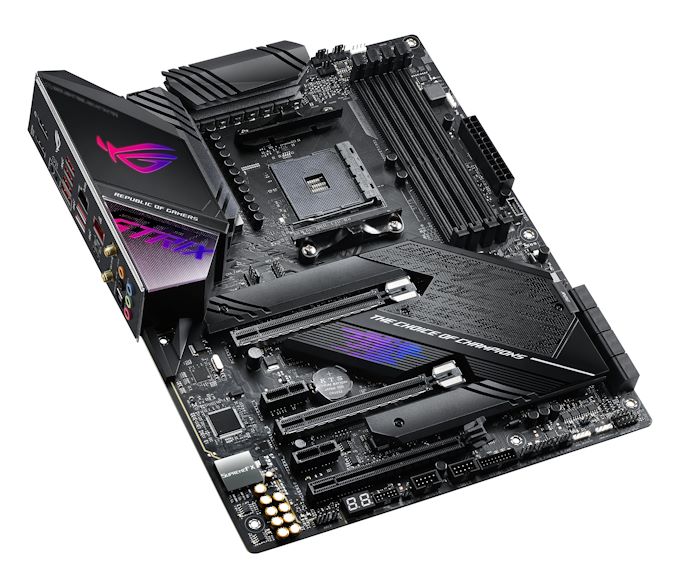The AMD X570 Motherboard Overview: Over 35+ Motherboards Analyzed
by Gavin Bonshor on July 9, 2019 8:00 AM ESTASUS ROG Strix X570-E Gaming
ASUS's Strix brand represents its more mid-range gaming focused offerings and the ASUS ROG Strix X570-E Gaming is one of two ATX sized Strix branded boards, with the X570-E being the more premium of the two models; the other being the slightly lower spec ASUS ROG Strix X570-F Gaming. Included is support for two-way NVIDIA SLI and up to three-way AMD CrossFire multi-graphics cards configurations, 2.5 Gigabit networking, and a Wi-Fi 6 wireless interface.
The ASUS ROG Strix X570-E includes the gaming-focused Realtek RTL8125G 2.5 Gigabit NIC with a second port controlled by an Intel I211-AT Gigabit NIC. The board's wireless capabilities come from the new Intel AX200 Wi-Fi 6 802.11ax adapter. The board boasts three full-length PCIe 4.0 slots which operate at x16, x8/x8, and x8/x8/x4, with the final four coming directly from the X570 chipset. The Strix themed chipset heatsink has two M.2 heatsinks emanating from the top and bottom side for the boards dual PCIe 4.0 M.2 and has a cooling fan integrated which is designed to keep the X570 chipset cool. The ROG Strix X570-E also has eight SATA ports and four DDR4 memory slots with support for up to 128 GB.
In terms of USB connectivity on the rear panel, there are three USB 3.1 G2 Type-A, one USB 3.1 G2 Type-C, and four USB 3.1 G1 Type-A ports. A SupremeFX S1220 HD audio codec powers the five color-coded 3.5 mm jacks, and an S/PDIF optical out, while a pair of video outputs consisting of an HDMI 2.0 and DisplayPort 1.2 output is featured. A handily located BIOS Flashback button and a single USB 3.1 G1 Type-A dedicated to this are clearly highlighted, and the ROG Strix X570-E also benefits from dual Ethernet ports with one being controlled by a Realtek RTL8125-CG 2.5 Gigabit NIC, while the other is driven by an Intel I1211-AT Gigabit NIC. There are also two antenna inputs for the Intel AX200 802.11ax Wi-Fi 6 wireless interface which also adds BT 5 connectivity into the mix.
The ASUS ROG Strix X570-E Gaming has an MSRP of $330 and represents its bridge between the mid-range and the higher end Crosshair VIII models. With Wi-Fi 6, 2.5 Gigabit + 1 Gigabit NICs and a SupremeFX S1220A HD audio codec and two-way NVIDIA SLI support, users looking for a high-quality ASUS X570 model may not have to look further than the Strix X570-F.












225 Comments
View All Comments
isthisavailable - Wednesday, July 10, 2019 - link
The industry needs to make up its mind when it comes to USB C. Laptops are launching with only USB C and meanwhile $700 motherboards only have 1 USB C port and 8+ "outdated" USB A'sThe_Assimilator - Wednesday, July 10, 2019 - link
It's almost like there's a huge amount of peripherals with USB-A connectors that people who use PCs expect to continue to work when they upgrade! Isn't backwards compatibility a funny feature?Meanwhile, the only peripherals that laptops generally use are docks, hubs, and storage devices - all of which have USB-C versions out the wazoo.
naris - Wednesday, July 10, 2019 - link
Why are memory speeds and channels show & discussed when talking about chipsets when the memory controllers are in the CPUs? Memory controllers have not been in chipsets for many years now!halfflat - Wednesday, July 10, 2019 - link
ECC support can be hard to verify for mere mortals; collating (or even better, verifiying) ECC capability on these motherboards would be an extremely useful addition to the article.ishkatar - Wednesday, July 10, 2019 - link
Does any of the boards support Raid 5? I only see 0, 1 and 10.Zibi - Wednesday, July 10, 2019 - link
You don't want to use RAID 5 without proper RAID Controller with cache.That means dedicated card.
Actually from performance / security perspective RAID 10 is pretty OK.
The_Assimilator - Wednesday, July 10, 2019 - link
AMD dropped RAID-5 support upon introduction of the AM4 socket (remember, chipset functionality like RAID is now a CPU function). I don't have an issue with that, since -5 is a very uncommon use-case in consumer workloads and if you want to do -5 right, you really want a hardware RAID card with a BBU.But -5 is pretty much dead anyway due to ever-increasing drive sizes - the rebuild time on anything over 1TB is horrendous, what you really want in such a scenario is RAID-6, and no consumer motherboard every has or will support that.
And please don't tell me you're using RAID-5 for data integrity, because invisible corruption is a thing that I have experienced personally. If you want *actual* data integrity, use Windows Storage Spaces or RAID-10, and as a last resort RAID-6.
Arbie - Wednesday, July 10, 2019 - link
There must be something you left out of this roundup. Whatever it was, please go back and put it in, and next time get it right. Thanks.Korguz - Wednesday, July 10, 2019 - link
huh ????Gastec - Wednesday, July 10, 2019 - link
That $700 must be an error right, perhaps of judgement?